#Visual Studio 2015 Support
Explore tagged Tumblr posts
Text

As pioneers of the new wave of British heavy metal movement, Iron Maiden achieved initial success during the early 1980s. After several line-up changes, the band went on to release a series of UK and US platinum and gold albums, including 1980's debut album, 1981's Killers, 1982's The Number of the Beast, 1983's Piece of Mind, 1984's Powerslave, 1985's live release Live After Death, 1986's Somewhere in Time, 1988's Seventh Son of a Seventh Son, 1990's No Prayer for the Dying, and 1992's Fear of the Dark. In 1982 the band released its album The Number of the Beast, the first with Bruce Dickinson, who replaced Paul Di'Anno as lead singer. This was a turning point in their career, helping establish Iron Maiden as one of the most important heavy metal artists in history. By 2010, more than 14 million copies of the album had been sold worldwide. Since the return of lead vocalist Bruce Dickinson and guitarist Adrian Smith in 1999, the band has undergone a resurgence in popularity, with a series of new albums and highly successful tours. Their 2010 album, The Final Frontier, peaked at No. 1 in 28 countries and received widespread critical acclaim. The sixteenth studio album, The Book of Souls, was released on 4 September 2015 to similar success, debuting at number one in the album charts of 24 countries with physical sales and summary in 43 territories with physical and digital sales. The seventeenth studio album Senjutsu was released on 3 September 2021 and eventually reached No. 1 in 23 countries.
By 2017, Iron Maiden had sold well over 100 million copies of their albums worldwide, despite little radio or television support. According to MD Daily Record by 2021 all audio-visual releases of the band have sold in over 200 million copies worldwide, including regular albums, singles, VHS', DVDs and all compilations. Iron Maiden have become one of the most influential and revered rock bands of all time and helped spawn an entire genre of music. According to many critics the band elevated heavy metal to an art form, proving that academic and musical inspirations can coexist.
3 notes
·
View notes
Text
ADEKUNLE GOLD IS CONSTANTLY EVOLVING

Adekunle Gold, the Lagos-born prolific singer, is one of the handful of Nigerian artists who can boast of a lasting presence in the highly competitive space that is the country's music industry. His was a journey of talent, consistency, invention and reinvention.
He was born Adekunle Kosoko, a member of the royal Kosoko family of Lagos Island, so when he chose to follow his passion in music, the name Gold readily appealed to him. Days spent riding to school with his father while they played Ebenezer Obey and King Sunny Ade, as well as lullabies sung by his aunt at bedtime, planted a love for music in the young Adekunle. With time, his love for listening to music spurred him to create his own. Like many other budding artists, he cultivated his talents first by joining the junior choir in his church and later, by forming a band with a close friend, Michael Bakare, before deciding to pursue a career as a solo artist. Michael remains a major musical pillar of Adekunle Gold’s career, his songwriting and production credits can be found as recently as Adekunle's latest album.
Nigeria's first introduction to the artist, however, was through his creative work as a photo editor. Prior to the release of “Sade” in December 2015, Gold had been given the title of 'King of Photoshop' for his creative editing of his images on pictures of actress Tonto Dike, OAP, Toolz and especially afrobeats queen, Tiwa Savage. A young Adekunle Gold had finished school with a diploma in Arts and Industrial Design and was putting his degree to good use, doing graphic design work for a number of YBNL artists, including Viktoh, Lil Kesh and even street-pop legend Olamide.
In 2014, Adekunle Gold released “Sade”, a cover of One direction's “Story of my Life”, and based upon a real life Sade who had turned his affections down. As the song gained ground, Pheelz, YBNL's in-house producer, saw there was more To Adekunle Gold's creativity than visual arts, and after conversations with label huncho, Olamide, Adekunle Gold was unveiled as a YBNL artist in March 2015. Then, he got a chance at a proper debut single, and "Orente" was born; a folksy Yoruba-supported love ballad, featuring distinct Yoruba instrumentation, which would grow to become his signature style. He followed this up with “Pick up”, which amped up production for a Juju-influenced song that would be an excellent fit for a live band.
All these built up to the release of his first studio album in July 2016, Gold that featured successes such as "Work", "Ariwo Ko", and another all time classic, "No forget", a duet with Simi, a friend and fellow artist who had previously mixed and mastered songs for him. His debut album was a critically acclaimed success, peaking at no. 7 on the Billboard World Album Chart.
His next studio album, About 30, was released in 2018 after exchanging amicable farewells with YBNL. He assembled a team of instrumentalists into a live band, named the 79th Element (Gold), and headed by Michael Bakare. As a result the album drew chiefly from his unique upbeat trad-style music which he christened Urban Highlife, and it housed a number of memorable songs like the energetic "Money", the evocative "Ire" and the sombre "Fame".
Until 2019 Adekunle Gold had operated firmly within the boundaries of his self-styled Afro Urban genre, where live instruments could meet with intoned delivery to channel some of the essence of Yoruba Juju music in a more modern setting. For the next step, though, it was time for an artistic refresh, and to achieve it, he will have to sacrifice some of his folksy essence for better mainstream appeal. And so he braided his boyish afro into a macho cornrow, while he discarded the Adire shirts for brightly coloured jackets and flowing kimonos, left unbuttoned to show his new buff physique, completing his look with tinted glasses and loose fitting pants. His switch in music was a lot less acute. For "Before You Wake Up", his first solo single of 2019, he maintained a similar delivery but production was different, employing more studio-made Afrobeats rather than the live drums and keys he was more popular with. Also subtle was his use of English and Pidgin for the entirety of the single, in the past Adekunle Gold had relied chiefly on Yoruba.
It was in 2020 that he properly donned the artistic personality he would take for his next era. First came "Jore", a duet with Kizz Daniel that leaned into Kizz's brand of casual afropop that was backed by catchy lyrics and a flowing beat. Then he released "Something Different", which was as it was named, a continual of the sonic detour he was making towards the mainstream. In mid 2020, “AG Baby" was released, the manifesto for his artistic vision; on the track he alludes to being the "street boy popping on the mainstream shit". “AG Baby’ was homonymous with his new persona, and on his next album, “Afro-Pop Vol. 1”, he delved properly into who he was now and what to expect of him. A song like “Okay” handled this orientation nicely, as he spun the mid-tempo pop groove into a song deriding his haters.
While AG Baby was morphing into the popstar, Adekunle Gold was settling into family life. His marriage to Simi was for many a bolt from the blue, but insiders into the couple’s lives knew they had been an item even before either of them made their debuts in the industry. Simi had produced, as well as mixed and mastered a chunk of Adekunle Gold’s Gold album, and Adekunle has gone on record to credit her with helping him find his music style. The pair had collaborated across a number of tracks over the years, each time bringing amazing chemistry that most fans did not know was the product of real life love they shared. On January 17th they released “Promise”, a tribute to their new union and the first official announcement of it. A little over a year later, in May 2021, “Happy Birthday”was released; a love letter to their daughter, Adejare on her first birthday.
2021 also saw him release three successful singles that would appear on his next album, “Catch me if You Can”, “Sinner” and “It Is What It Is” followed the laid back, less-is-more delivery of his newly perfected style. But “High”, featuring industry heavyweight Davido, was a different dish altogether; an Amapiano heavy hit, foreshadowing another shedding, or perhaps more accurately, an extra layering of personality that would lead AG Baby to give way to Tio Tequila. The lover boy Adekunle who had withstood the transition from Adekunle Gold to AG Baby evolved to another man for whom “Love is not enough”.
His latest project, Tequila Ever After, is named after this new persona, and here he slows down his Afropop cadences to take in parts of Dancehall and RnB. By far his biggest project, Adekunle Gold assembled RnB megastars like Pharrell Williams and Khalid as well as budding Nigerian street stars like Zinoleesky and Odumodublvck. He has already hit the charts with two singles, “Ogaranya” and “Party No Dey Stop”, so he will be hopeful others can quickly follow suit. More importantly, though, he will hope his new project, and the persona he introduces with it, can significantly advance his global intentions. Adekunle Gold has described his latest project as a celebration of his wins so far.
With a solid discography encompassing five successful projects, a recently bagged contract with an international label in Def Jam Records and a career about to reach the 10 year mark, a celebration is much needed and well deserved. As the artist readies himself to consolidate his position in the Nigerian market and expand his wings even further beyond the shores of the country, he can take a shot of Tequila and toast to his wins so far, because it only gets better from here.
This article was written by Afrobeats City Contributor Ezema Patrick - @ezemapatrick (Twitter)
Afrobeats City doesn’t own the right to the images - image source: Instagram - @Adekunlegold
#Afrobeats#AfrobeatsCity#Adekunle Gold#Africa#African music#Afropop#Afrobeats article#Article#Music#Nigeria#Nigerian music#Def Jam#Tequila ever after
8 notes
·
View notes
Text
HER ...... ROCKET MAN
youtube
HER
The story of HER is characterised by massive successes and tragic strokes of fate, by triumph and tragedy in equal measure - but ultimately it is above all the story of a friendship: that between Victor Solf and Simon Carpentier.
German-born Victor and Frenchman Simon met back in 2007 - they were still at school - and the two hit it off like brothers. When they started making music together, their sound was equally influenced by classic soul à la Otis Redding and hip-hop from the post-"Yeezus" phase. They gave their project the name HER in 2015.
Their music became instantly recognisable when the early song "Five Minutes" was used as the soundtrack for Apple's "Shot on iPhone" campaign - which ultimately earned them more than 6.7 million streams on Spotify. The duo from Rennes with Franco-German roots then released the EP series "Her Tape #1" and "Her Tape #2", which were peppered with highlights such as "Quite Like", "Union" and "Her" - which in turn meant more than 20 million additional Spotify streams for HER. Behind the seductively provocative visuals that adorned their covers was a subtly dreamy newer wave sound, minimalist, somewhere between pop and soul, in which jazz elements also flickered - and so the two best friends circled the globe several times, presented the EPs live and also made a decent wave in the States.
So much for the numbers, the impressive successes of the last two or three years - because in the midst of all the hustle and bustle, Simon lost a long, hard, silent battle against cancer, which hardly anyone outside his closest circle of family and friends realised: he died a few months ago, in August 2017.
"The whole of last year was incredibly hard because Simon was so unwell," reports Victor. "For example, it was incredibly difficult for him to do our tour - but he also thought it was important to carry on and give concerts! He just didn't want to give up, he didn't want to stop... he battled with this illness for six years. And we didn't actually talk about cancer or death that much during that time: We wanted to talk about life instead. And now, I think it's my job to continue this line and this approach. It's really difficult for me, but I'm doing my best - for myself and for him."
With the support of his late friend, at least in spirit, Victor went back into the studio and continued working on their debut album "HER", which will be released by Republic Records in 2018. He put the finishing touches to the existing songs and also returned to the stage in between: among other things, he played a stunning, deeply moving set at the Rock En Seine Festival in Paris - a festival, incidentally, where HER had always wanted to perform. More shows followed all over Europe and then the album was as good as finished: "Most of the songs were already finished beforehand; they just needed some fine-tuning on the vocals, the background vocals...", he reports. "It was just important to me that Simon's voice, Simon's vision and his guitar playing remained virtually untouched and really sounded exactly how he wanted them to in the final version. I worked on that."
With the single "We Choose", HER have already released a significant album harbinger in advance: Simon's unmistakable voice spreads out over an extremely minimalist, light and smooth production, meaning that his presence can be felt immediately and his signature is unmistakable. "The strange thing is that this was the very first song we wrote as HER - and also the last one I recorded with Simon," explains Victor. "We wrote it just as our previous band was coming to an end. We wanted to make a real statement with it: that you can't lose hope, that you have to hold on to what you love. We were working on new ideas every day back then, and this song just stood out because we were also about holding on and carrying on - after all, there were people back then who thought we were going to stop completely now that the other band had ended. Well, we didn't stop. And I think now is the perfect time to release 'We Choose': Because even when things are bad, there's still one thing - hope. The song is kind of the prologue to the next chapter. A chapter that will hopefully continue the way he would have wanted it to."
While the band started this new chapter with a sold-out concert at the Bataclan in Paris, the music of HER remains the best and most tangible proof of how unique the chemistry and bond between the two band founders was.
"It's just extremely important that this album comes out," Victor concludes. "It's the only way for me to come to terms with his death. This is music forever, for life."
#her#Victor Solf#Simon Carpentier.#rip#sound of my life#at the olympia#2018#rocket man#so beautiful#Youtube#Colombo Records
2 notes
·
View notes
Text
CV
SHELLEY THEODORE Born in Brisbane, Australia Lives and works in London, Barcelona and France https://shelleytheodore.tumblr.com/ https://www.axisweb.org/p/shelleytheodore/ EDUCATION 2012 MA Visual Art (Fine Art), Camberwell College of Art, University of the Arts, London 1995 Bachelor of Fine Art (Hons), Goldsmiths College, University of London 1992 Dept of Continuing Education, Goldsmiths College, University of London, Certificate in Art 1980 Bachelor of Social Work, University of Queensland, Australia SELECTED EXHIBITIONS AND PUBLICATIONS 2022 Artist Feature Special Issue: Best Artists of 2022 Magazine 43, Hong Kong 2022 Magazine 43 Film Friday featured artist April 2022 https://magazine43.substack.com 2021 Deptford X Festival, Art in the open Supported Application Guide shapeslewisham introducing@shelley_theodore 23 March 2021 Deptford London 2021 Post Analogue Labyrinth IV, virtual exhibition, https://www.artsteps.com/view/ 6092eeaca33cc06fe89a823f 2019 Post Analogue Labyrinth Ill, as part of DEPTFORD X FRINGE, AAJA Deptford 2018 Post Analogue Labyrinth 11, Sister Midnight Records 4 Tanners Hill London Gaze, Axisweb: Contemporary Art UK Network, online exhibition Aesthetica Issue 81, p157, Artists' Directory, Published on Jan 24,2018 2017 Drawing Open, 26 -28 May, No Format Gallery, Arch 29, Rolt Street, Deptford 2016 Prison Drawing Project, Dean Road Prison, Scarborough, UK Artrooms Fair 2016, Melia Whitehouse Hotel, London 2015 Uncertain States Annual, Mile End Art Pavilion, Mile End 2014 Pala, an online digital program of artist's film and video works curated by Laura Mansfield 2013 Bloomberg New Contemporaries 2013, Spike Island, Bristol, and ICA, London 8 STUDIOS FROM HERE, Faircharm Studios, Deptford Postcard From My Studio, Acme Project Space 44 Bonner Road, Bethnal Green, London 2012 Crash OPEN, Charlie Dutton Gallery, 1a Princeton Street, London The Salon Art Prize Exhibition 2012, Matt Roberts Art, 25b Vyner Street, London Jerwood Drawing Prize Exhibition 2012, Jerwood Space, London No Now, Space Station Sixty Five, Kennington Bend over Shirley, Beaconsfield Contemporary Art 2011 CCW Artist Moving Image, HMV Curzon, Wimbledon 'Chain letter' worldwide exhibition 2011, GIBSMIR family, Zurich, Switzerland. Flash in the Pan, curated by Naomi Sidefin and David Crawford, Beaconsfield Contemporary Art The Unsung Heroes of the studio, ASYLUM, The Chapel, Caroline Gardens, Peckham 2010 Peckham Space Open, Peckham Space, Peckham Deptford X Fringe Award, Deptford X Fringe Nunhead Open Art Exhibition, The Surgery, Nunhead 2009 Creekside Open, selected by Mark Wallinger, APT Gallery, Deptford Creekside Open, selected by Jenni Lomax, APT Gallery, Deptford 2008 London Art Fair, Islington, Beverley Knowles Fine Art 2007 London Art Fair, Islington, Beverley Knowles Fine Art RESIDENCIES 2022 Studio Residency, San Quirze Safaja, Barcelona 2021 Photography Workshop with Architect Lisa Harmey and architecture students University of Cardiff, UK 2015 'Backs to the Future' Residency, FIVE YEARS 66 Richmond Studios, 8 Andrews Road, E84QN 2014 2014 LUX Critical forum, London 2012 Gasworks Curatorial Workshop, Gasworks 2011 Urban fabric 2 (UF2) Paradox Conference, Crawford College of Art and Design, Cork, Ireland 'Sculptural Drawing Collaboration', The Woodmill Project Space, Bermondsey
2 notes
·
View notes
Text
i’m constantly reminded of mortality, and it doesn’t bother me the way you’d think
repost from that time i deleted an article i spent 4 days on T-T actual post this time since i somehow posted it privately yesterday 😭
---
Hi, I’m Questioning. And I like to waste my life away dedicate my free time to random hobbies that catch my hyperfixation interest on the fly. Currently, I’ve returned to something most important. Updating the encyclopedia-esque database of AlternativeTo.net. o_o
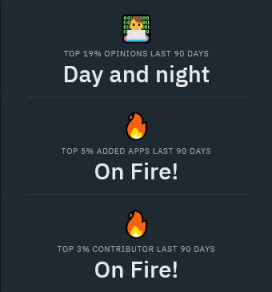
Let me finish.
See, I started exploring the world of Visual Novel (VN) makers, which led to me discovering the world of Interactive Fiction (IF)–their predecessor afaic. And that’s where it got strange. What I’ve found is interesting developments in terms of innovation and such. Like Undum (image)–“a game framework for building a sophisticated form of hypertext interactive fiction” according to its GitHub. IFWiki calls it “an authoring system for CYOA-style stories playable on web browsers.” It was created by I.D. Millington in 2009, released in 2010, had returned in 2018, and would’ve changed the IF genre (kinda like Twine did) if not for how hard it was to get into.
Undum’s flexibility and power have made it the engine that drove some of the most significant works in IF (The Play, Almost Goodbye). But it has always been relatively inaccessible. Undum is not the system of choice for writing straightforward hypertext games; it’s a challenging system to learn and use that demands the author build their own engine on top of it to drive their game logic. Consider Raconteur for “Undum with batteries included.” -Bruno Dias (x)
Enter Raconteur, “a friendlier way to write Undum hypertext fiction” that was announced by Bruno Dias in 2015. More accurately described as “a library of Undum tools that can get someone writing their story quickly.” Here’s the thing about the “library of Undum tools” part: Undum did not come prepackaged with any… even though they were required to write your game,…😐 which “meant doing a lot of your own tooling.” 😑
Yeah, no surprise it won the award for Best Technological Development in XYZZY Awards 2015.
But hold up, somethin’ ain’t right…
Undum’s only got 21 games on IFDB.org and Raconteur’s got 4… with 1 overlap with Undum. 😐
So~… wth?
Well, someone else had a similar question on intfiction.org in March and got Josh Grams’ opinion on it: JavaScript.
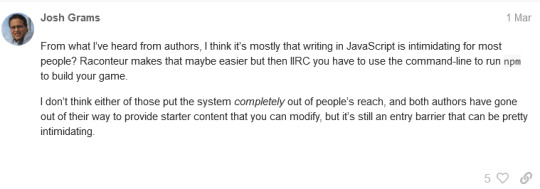
🤷🏿♂️
So even though Undum was designed as the visual version of bookbinding and with the specific goals “aesthetic” & “technical” in mind, shit’s too intimidating compared to alternatives.
I hoped [writing Undum in JavaScript] would make it accessible for a wider range of dabblers, requiring transferable skills rather than learning a new language. It also made it achievable to write and document over a few weekends: I didn’t have to worry about parsing, or creating a complete runtime. But the best benefit, and in some ways the one least exploited in practice, is the ability to use Undum as part of a bigger game. I imagined a strategy game with CYOA elements, or a piece of interactive fiction using natural language generation to be different each time. -Ian Millington (x)
And here’s~ where it gets a bit fucked.
Remember the other person who had a similar question–J. J. Guest? Well, they ended their post with “Was it simply superseded by Ink / Inky?”

Let’s keep this simple:
Ink [image] is the core narrative engine itself, written in C#. It includes the code for the compiler. If you’re not technical, you don’t need to worry about this. Inky [image] is our ink editor, which is a text editor with support for playing as you write. If you’re just starting out with ink, this is all you need. inkle is the game development studio that created ink (x)
So it’s “a narrative scripting language for games” and yet another CYOA maker. Why do I bring them up? Well, Inkle (the company) “was founded in 2011 by two Cambridge game developers [Joseph Humfrey & Jon Ingold] with a passion for storytelling and beautiful design” (x). They started off with their unique “inklebook” format, which had an early prototype game in ~2008 that Jon described as
an iPad-based choice-driven story made of ‘pages’ which stitched together into a single flow via frequent choice points. It was a lovely UI for a choice-based game, even in prototype form, and we had a strong scripting language underneath it – the first version of ink. (x)
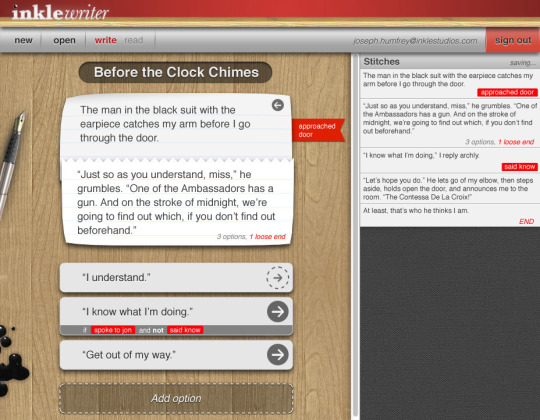
In January of 2012, they released “a web-tool for writing and reading simple interactive stories” called inklewriter. Joseph described it as “a simpler subset of the inklebook format” (x) and admitted “inklewriter was partly born out of the surprise that there isn’t anything out there for quickly and easily writing non-linearly.” (x)
After already having “moved away from developing inklewriter for a long time,” it went “permanent beta” in September of 2017 due to “increasing frequency of persistent bug-reports.” Sad news considering the statement “we’ve had hundreds of thousands of stories created by hundreds of thousands of users; we’ve won awards from school and library associations; and hopefully we’ve helped kickstart a few interactive writers careers” (x). And since writers (who became aware in time) were able to “rescue” their story from the bugs and potential wipeout with a simple Save Page As, it was probably a bit less heartbreaking when inkle revealed less than a year later that inklewriter would be shutting down completely in August of 2018. Seemingly because “it’s real work to fix the issues that arise” with the constant browser changes. 😐
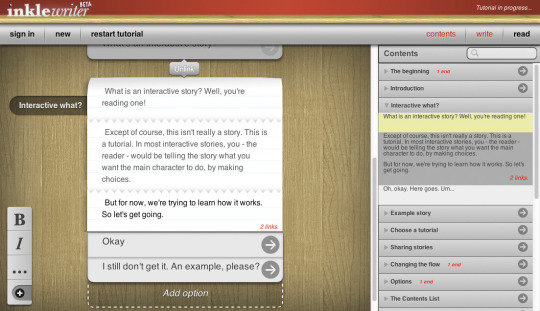
Only 7 months later, it returned in March of 2019. Stable, still free, and now open-source after developers in the open-source community “produced a full port of inklewriter to modern web-tech.” 🥳 Writers needed to make new accounts and import their stories to the new database, but that was it. And since the legacy version was (and is) still around, they could do it pretty quickly. (x)
But where dahell was I going with this? Let me tell you about the original connection first: Unity Integration.
The [ink-unity-integration] plugin provides you with everything you need to get started with ink in Unity. It automatically recompiles ink files as you edit them, and even comes with a simple previewer that lets you play stories directly within the Editor, without writing a line of code. (x)
Remember Ian Millington’s statement from awhile ago? “But the best benefit, and in some ways the one least exploited in practice, is the ability to use Undum as part of a bigger game. I imagined a strategy game with CYOA elements, or a piece of interactive fiction using natural language generation to be different each time.” (x)
Well,… Stoic Studio (announced that they) did it in January 2013 when they used inklewriter for The Banner Saga. Though, inkle recommends you use their ink scripting language instead for Unity projects. 🤷🏿♀️ A scripting language that was ported to JavaScript in May of 2016, btw. The port (inkjs) having its latest release just 6 freaking days ago while Undum and Raconteur had their last GitHub edits in 2018 & 2020 respectively.
Either way, Ian’s imagination of “a strategy game with CYOA elements” happened… with another mofo’s software. 😐
And what’s that? I left something out?
I left working on Undum to develop Varytale, a short lived commercial IF endeavour that shared a lot of the same aesthetic and narrative structure. And then I retired, and it lay fallow, aside from email help requests that still drip into my inbox. -Ian Millington (x)
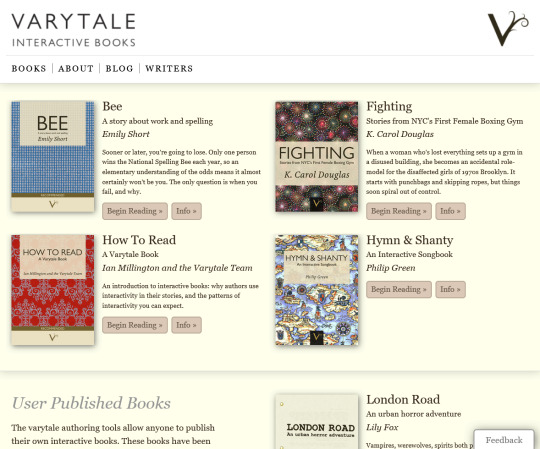
Let’s see what IFWiki says about this endeavor:
Varytale was a platform for authoring and publishing browser-based CYOA, created by Ian Millington and Alexis Kennedy; it occupied a point somewhere between Undum and StoryNexus [a comparatively mostly defunct endeavor from 2012]. The Varytale website was live from approximately 2011 to 2015. The first posts on Varytale’s blog appeared in June 2011. On March 7, 2014, Varytale posted a comment on the Varytale Facebook page saying, “The project is stalled, due to key people leaving the project. So there’s no news, and I’m not sure if or when there will be.” The last Wayback Machine snapshot of www.varytale.com/books was taken in September 2015. (x)
On its May of 2012 public beta announcement on FailbetterGames website, something slightly poignant was said.
But the technology is great [seriously] - it’s easily the most flexible and powerful tool of its kind, and it’ll be fascinating to see what people can do with it once the writers’ programme opens up. And as it happens, Jon Ingold / Joseph Humfrey’s very elegant inklewriter has also just gone live [4 months prior]. (…) …[inklewriter] covers some of the same territory as Varytale, but it’s (by design) simpler in concept and execution. (x)
Life is truly cruel.
If you check the archive from possibly days before its shut down in September of 2015, you’ll see 4 official books (Bee, Fighting, How To Read, Hymn & Shanty) and 3 User Published Books (London Road, Sixth Tower, Tillinghast). That’s 7… 7 books. 😐
But it’s not that sad. According to the Varytale blog’s 2nd to last post (in June of 2012), “we passed 50,000 reads across the seven books currently on our reader’s beta.” This was perhaps a full week after they released the floodgates and actually allowed people to start readin’. Das alot to me. They clearly succeeded in “building a platform for authors to write great books, and for publishers to publish them.” Even built a whole-ass “system that does generative design,” creating “artwork based on the author’s choice of patterned design or photograph” (x). Or, as we’d quickly say 12 years later, some AI shit.
So wut 👏🏿 in da fuq 👏🏿
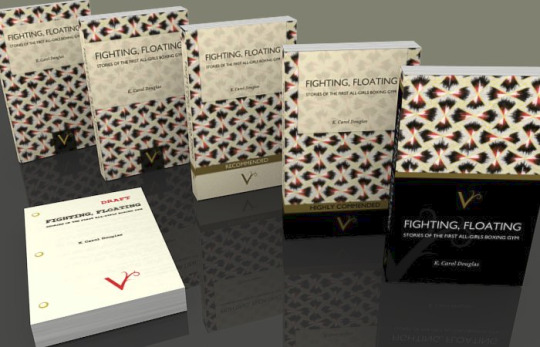
Why’d they never get past the 7 book mark in the 2 years between Reader’s Beta and project stallation? Well,… there’s a hint at the end of that 2012 blog post: “We have a queue of people wanting to write content, who are been added a few at a time. So lots of hard work in the beta still to go.” hm~ 🤔
If The Way Back Machine had archives past January of 2013, we’d definitely know more, but this is it (i ain’t diggin’ a wider hole at this point). And what is it? I think it’s a matter of workload. Too much for too few people who had however much goin’ on in their lives. Remember much earlier this bit from IFWiki?
On March 7, 2014, Varytale posted a comment on the Varytale Facebook page saying, “The project is stalled, due to key people leaving the project. (x)
Maybe things weren’t smooth enough for awhile. Maybe it was something else for those 2 years prior. 🤷🏿♂️ And you know… the end of Emily Short’s blog post Writing for Varytale might hold the answer.
There are still some challenges about using the Varytale system, though it’s evolved tremendously over the course of beta. One of the biggest authorial challenges is that, while there’s the awesome structure tool shown above for looking at branching structure inside a storylet, it can be considerably more challenging to get a view of what’s going on at the macro level. And I’m not even sure what the tool for this ought to look like. The strength of storylets is that they can affect which other ones pop up in a fairly freeform way, and one can affect another (via their shared stat use) without explicit logic in either. But that’s also what makes it really hard to graph how they will act. Most of the bugs that arose in Bee were related to this issue of envisioning the total structure of the work and detecting storylets that were going to break that structure. (x)
So in this case aswell, the innovations of Ian’s Varytale make it… (a bit) intimidating to work with. 😑Whether or not this difficulty was ever ironed out post-beta is unknown to me, especially considering the end of Ian’s thankful response to Tom H.’s suggestion for fixing the macro level problem: “When will I get chance to code it? That’s a whole other matter!”
…hm~
And on the same post lies magnus4444’s statement that “There isn’t a lot of documentation out there yet on the implementation of more advanced effects but, on the plus side, Ian is generous with advice and tips.”
🤷🏿♀️
So wtf do we have here. Effectively two developers (i’m simplifying it; fight me) who 1) made a CYOA maker (Undum & inklewriter) for very similar reasons, 2) put development aside to focus on other CYOA makers (Varytale & Inky), 3) had their neglected work taken up by open-source developers for the good of everyone, and 4) reaped the benefit of the other’s labor in some way. Now, here’s where we’re back to the sad part. Inkle’s version of the tale is the American Dream ™. Inklewriter was beloved by many and had mainstream success. Ian’s version is the harsh American Reality. Undum only bore 24+ games over the course of its 13 year existence on the internet and in the world of IF. And if a single person’s opinion is to be taken as fact… then the reason was simple: shit wasn’t easy to pickup. And thus, regardless of Ian & Bruno’s efforts, it (at this rate) is bound to become an obscure software regardless of its potential. All while Varytale remains gone and Inky (released in June of 2016) is still goin’ strong with 160+ games released using its Ink language/engine.
Which brings me back to the matter…
i’m constantly reminded of [my] mortality
#article#long post#looooooooong#Undum#Raconteur#Varytale#inklewriter#inky#inkle#AlternativeTo#Visual Novel#VN#Interactive Fiction#IF#GitHub#IFWiki.org#CYOA#I.D. Millington#Bruno Dias#XYZZY#IFDB#JavaScript#Ian Millington#inklebook#Stoic Studio#The Banner Saga#inkjs#Alexis Kennedy#Emily Short#once again i'm gonna say that i think the key reason for Ian's efforts being less successful than inkle's is marketing
1 note
·
View note
Text

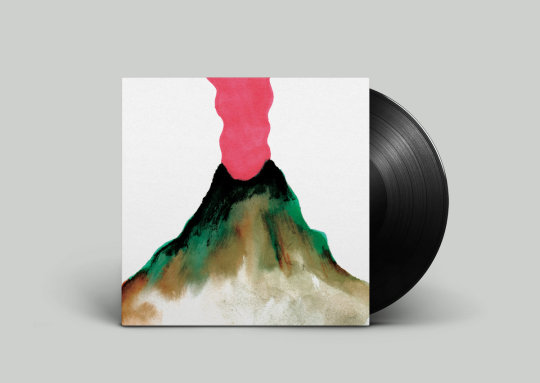













Saint Sadrill "Pierrefilant" 2018 double LP + "Frater Crater" 2024 Lyon France Psych,Indie Pop Rock,Experimental Art Pop,Alternative Rock
full spotify
https://open.spotify.com/album/3eVcT98BT6SwEt32E7TP7t
https://open.spotify.com/album/5RTOWMijZkdkxOT9Hm80Of
Saint Sadrill is the name of the pop goldsmiths of Antoine Mermet, a discreet but hyperactive biped, whose second collective album, Frater Crater, arrives after six years of silence. The spirits of James Blake and Mark Hollis seem to have been summoned to a banquet hosted by Scott Walker and St Vincent. Call it avant-pop, indie emo, or lo-fi chamber music with an experimental twist. - - The seven songs of Frater Crater follow one another like so many places whose lighting varies from blinding halogen to disturbing darkness, without passing through the ideal sun. While the band's musicians remain the same - vibraphone, guitar, keyboards, drums and bass - the instrumentation has been expanded to support Antoine Mermet's vocals: accordion and synthesizers have been added, serving as levers for the deployment of intriguing soundscapes. If from time to time a deluge is triggered, the phenomenon stops before the water reaches the nostrils: drowning is still avoided, but clothes are weighed down. In other words, a music that is both innovative and accessible, capable of breaking the hearts of lovers of the melodic evidence as well as those of the avant-garde: sophisticated arrangements and complex structures jump to the ears as much as melodic discoveries of irresistible efficiency. The whole thing sounds dusty but lush, 666% emo and immature: the lyrics ask unanswered questions, detail hours of immobility and desires for superpowers, while the music goes back and forth between emptiness and overflow. - - Frater Crater follows Pierrefilant, a first collective album recorded in 48 hours and released in 2018, which followed the release of Building Lampshades, a synth pop solo EP in the form of a sketchbook, released in 2016. It is carried by a close-knit group, neither chamber ensemble, nor rock band, nor all of these at the same time. It includes key musicians from Lyon's innovative music scene, who have in common that they prefer creativity to respect for the rules. - - When he's not writing sad songs, Antoine plays the saxophone and sings in CHROMB! and explores in Vocoder or Bouche Amplifiée. And when he's not making music, he plays for Alice Laloy or Guillaume Bailliart, dances for Nitsan Margaliot, plays for Nile Koetting, Megan Cope, collaborates with Tiphaine Calmettes' exhibitions and performances or shows his own visual work. Consistency and specialization are clearly not his strong points. Saint Sadrill is his personal project, a group he formed in 2015 by inviting five musicians and friends who have long since abandoned devotion to a precise aesthetic, preferring openness and exploration......~
Saint Sadrill "Pierrefilant" 2018 double LP
Credits Melissa Acchiardi | vibraphone, percussions Lionel Aubernon | drums, electronics Lucas Hercberg | bass Antoine Mermet | lead vocal Anne Quillier | keyboard, synthesizer Vincent Redoux | guitar Jerôme Rio | recording and mixing Guillaume Toulec | mastering at Purple Sheep Studio Clément Dupuis | executive production Soia | artwork Tracklist Waiting For Him 11:32 Corq 4:44 To Go To Go To Go 5:13 Zero 6:46 Yar Mum 3:56 We Gave You A Smile 3:33 Building Lampshades 2:38 Kiss Song 4:57 Little Mountain 6:05 Happy Humans 19:27
Saint Sadrill "Frater Crater" 2024
Tracklist 1. The Soil From The Hill 2. Pebble [Take It In Your Hand] 3. I Look At The White Balconies 4. Best Joke [The First Of April] 5. This Morning In The Ring 6. Empty Chair Vs Lonely Seat 7. Seven Days Minus One Week
Saint Sadrill "Pierrefilant" 2018 double LP + "Frater Crater" 2024 Lyon France Psych,Indie Pop Rock,Experimental Art Pop,Alternative Rock
https://johnkatsmc5.blogspot.com/2025/05/saint-sadrill-pierrefilant-2018-double.html?view=magazine
https://johnkatsmc5.tumblr.com/post/783820024495341568/saint-sadrill-pierrefilant-2018-double-lp
0 notes
Text
Jagran Lakecity University - [JLU], Bhopal
Jagran Lakecity University (JLU), located in Bhopal, Madhya Pradesh, is a well-regarded private university established in 2013 under the Jagran Social Welfare Society. It is recognized by the University Grants Commission (UGC) and is one of the fastest-growing universities in Central India. Known for its strong industry-academic partnerships, global collaborations, and student-centric approach, JLU offers a modern educational environment focused on innovation and employability.
Academic Structure and Programs
JLU offers a wide variety of undergraduate, postgraduate, and doctoral programs across multiple disciplines through its dedicated schools:
The School of Engineering and Technology offers a Bachelor of Technology (B.Tech.) degree in several specializations, including computer science, artificial intelligence, and cybersecurity. The curriculum emphasizes hands-on learning and new-age technologies.
The School of Business offers a Bachelor of Business Administration (BBA), a Master of Business Administration (MBA), and specialized programs such as Business Analytics. The business school works closely with industry partners to offer real-world exposure.
School of Law: Offers BA LLB, BBA LLB, LLM, and Ph.D. programs. The school is known for its moot court training, legal aid clinics, and judicial internships.
School of Journalism and Mass Communication: Recognized nationally, it offers programs in journalism, media production, and communication. Students get practical training in digital studios and field assignments.
School of Design and Creative Arts: Offers degrees in Fashion Design, Interior Design, and Visual Arts, focusing on creativity, innovation, and design thinking.
School of Computer Applications and IT: Offers programs such as BCA and MCA, equipping students with knowledge in software development, database systems, and computer networks.

Infrastructure and Campus Life
JLU’s 40-acre campus in Chandanpura, Bhopal, is equipped with modern facilities designed for academic excellence and holistic development. Key features include:
Smart classrooms and high-tech laboratories
A central library with over 35,000 physical and digital resources
Separate hostels for boys and girls with all modern amenities
Cafeteria offering a variety of nutritious meals
Sports facilities including basketball courts, football grounds, gyms, and indoor games
Medical support with on-campus health care services
Student life at JLU is vibrant, with numerous clubs, societies, and events. Cultural festivals, seminars, sports meets, and student-led initiatives keep the campus lively and engaging.
Rankings, Accreditations, and Recognitions
JLU has received a Diamond rating from QS I-Gauge, making it the first university in Madhya Pradesh to achieve this distinction.
It has been ranked among the top private universities in India by Education World.
It earned the E-LEAD Certification from QS I-Gauge for excellence in online and digital learning.
The university was awarded “University of the Year” by the Government of Madhya Pradesh multiple times between 2015 and 2019.
JLU is also recognized internationally and has represented India at forums like the House of Commons in London.
Placements and Industry Interface
Jagran Lakecity University has a strong track record of placements, with more than 80% of students placed annually. The university has partnerships with leading national and multinational companies including:
Amazon
Accenture
Wipro
TCS
Deloitte
HDFC Bank
Infosys
In 2023, the highest package offered was ₹14.25 LPA, while the average ranged between ₹4–6 LPA depending on the course and specialization.
JLU has also partnered with international universities across the UK, USA, and Europe, offering student exchange programs and global exposure.
Admissions and Scholarships
Admissions at JLU are based on merit, entrance exams, and personal interviews. For programs like B.Tech or MBA, national-level test scores (like JEE, CAT, and MAT) are considered. The university offers scholarships based on academic merit, sports performance, and need-based criteria.
Conclusion
Jagran Lakecity University is emerging as a modern, student-focused institution offering quality education with a global outlook. With strong academic programs, industry-aligned training, global partnerships, and an engaging campus environment, JLU provides a comprehensive platform for students to grow both professionally and personally. It is a strong choice for students seeking a future-ready education in Central India.
#JagranLakecityUniversity#JLUBhopal#JLU#PrivateUniversity#StudyInIndia#CampusLife#EngineeringAtJLU#BTechJLU#BusinessSchool#LawSchoolIndia
1 note
·
View note
Note
Honestly it’s a good thing that they’re pausing those live action movies. I hope Snow White taught them a lesson about the importance of creativity and taking risks over money and also that supporting a genocide WILL negatively impact your productions (but I doubt they have grasped that).
HOWEVER, we could still have live action, family friendly adaptations of fairytales that are just as great as their 2015 Cinderella movie, if they’re made by another big studio that actually cares! I’ve read somewhere that the live action Disney movies after Cinderella were supposed to follow the same formula and be retellings rather than recreations of their animated movies. Beauty and The Beast (2017) was supposed to be that, but they changed their mind and decided to make it a musical because of the success of Frozen.
But that doesn’t mean that another studio can’t follow the Cinderella formula to make new adaptations! Disney took inspiration from the concept art and rejected ideas they had for the 1950 movie to make 2015 version. Another big studio should do the same and actually take the interesting plot or character ideas that Disney originally scrapped for their movies and look at the early concept art for inspiration to create the visuals for their new adaptations! That way, it could be “Disney” without “officially” being Disney! It would be a great way to expand on popular pieces of media without touching the original versions! It’s like how Wicked takes inspiration from the 1939 Wizard Of Oz film but still create their own iconography instead of copying it. But it’s has so much of the essence of it that it technically makes it part of the same universe, even if they were made by different studios.
And they should do this out of spite every time Disney has plans to do a live action remake! It’s not like they’re ever going to use the scrapped ideas anyway, since they’d rather make dull, cheap-looking, less good copies of their animated classics that are mass produced like Shein clothing rather than be creative! So somebody should show them how it’s done and make them pale with successful adaptations lol
~🌝
Oh definitely! They should focus on making actual new things and not just some live action version of movies we already know. I agree with you and this should also teach them a lesson to stop hiring people just because they’re considered attractive because besides all the problematic shit Gal Gadot is involved with, she’s not a good actress at all 😭
Something it would be sooo interesting would be if another studio started making movies about fairytales but the original versions, you know? Including all the horror some of them have. At least as someone who’s a fan of horror genre I’d love to see this kind of version of popular fairytales.
It feels like other studios are scared to make films about fairytales like it’s a Disney thing only. I miss movies like Shrek, or Snow White and the Huntsman (but honestly I prefer the second movie, maybe because of Charlize and Emily lol).
1 note
·
View note
Text
Макс Роботов, учасник резиденції Вибачте Номерів Немає у лютому - квітні, 2025 року
Макс Роботов народився 1982 року в м.Луганськ. У 2005 році Максим закінчив Національний аерокосмічний університет ім. М.Є.Жуковського ХАІ в м.Харків. Практикує роботу з новими медіа та сау��д-артом. У 2008 році спільно з Лєрою Полянською заснували мистецьку групу SVITER. Разом з Лєрою Полянською та Іваном Світличним у 2009 році в Харкові заснували та були кураторами творчо-експозиційного центра ТЕЦ, а у 2013 році також разом заснували експозиційне середовище «Шухляда» – кураторську онлайн-платформу. У 2018 році на базі власної майстерні Макс разом з Лєрою Полянською та Іваном Світличним відкрили школу Photinus, спрямовану на розвиток нового медіа-мистецтва в Україні. Макс з 2015 року є учасник Інституту нестабільних думок. У 2017 році учасник 57-ї Венеційської бієнале в рамках проекту «Парламент", Український павільйон. У 2018 році учасник фестивалю transmediale Vorspiel 2018. З 2022 року служить у лавах ЗСУ.
Резиденція ВНН звертає увагу на роль культури та мистецтва в часи російсько-української війни, має на меті реалізацію інституційно критичних проектів пов'язаних з культурною спадщиною (матеріальною і нематеріальною), розвитком художньо-культурних інституцій.
Програму резиденції ВНН та участь Макса Роботова реалізовано завдяки грантовій підтримці від The Académie des beaux-arts in Paris (French Academy of Fine Arts). Та Центру Візуальної Культури спільно з Київською Бієнале.
Світлина у пості надана Максом Роботовим
(eng)
Max Robotov, participant of the residence Sorry No Rooms Available in February-April, 2025
Max Robotov was born in 1982 in Luhansk. In 2005, Max graduated from the National Aerospace University named after M.E. Zhukovsky KhAI in Kharkiv. He practices working with new media and sound art. In 2008, together with Lera Polianska, founded the SVITER art group. In 2009, they founded and curated the CEC creative and exhibition center in Kharkiv, and in 2013 they also co-founded the Shukhlyada exhibition space, an online curatorial platform. In 2018, Max, together with Lera Polianska and Ivan Svitlychnyi, opened the Photinus school on the basis of their own studio, aimed at developing new media art in Ukraine. Max has been a member of the Institute of Unstable Thoughts since 2015. In 2017, he participated in the 57th Venice Biennale as part of the Parliament project, Ukrainian Pavilion. In 2018, he participated in the transmediale Vorspiel 2018 festival. He has been serving in the Armed Forces of Ukraine since 2022.
The SNRA residence draws attention to the role of culture and art during the russian-Ukrainian war, aims to implement institutionally critical projects related to cultural heritage (tangible and intangible), development of artistic-cultural institutions.
The SNRA residency program and the Max Robotov’s participation were implemented thanks to the grant support from The Académie des beaux-arts in Paris (French Academy of Fine Arts). And the Visual Culture Research Center together with the Kyiv Biennale.
The photo in the post was provided by Max Robotov

0 notes
Text

SULKI & MIN POSTER
The 2014 Gwangju Biennale poster, titled “Burning Down the House,” was designed by the Seoul-based studio Sulki & Min. Known for their experimental typographic style, which uses bold design to communicate powerful messages. The target audience includes artists, and the broader public interested in contemporary art and culture. The design reflects the theme, referencing destruction as a metaphor for transformation and renewal.
The poster uses bold, capital writing in a bright orange colour against a white background, which is a simple yet powerful design feature. The stacked text layout in both Korean and English draws the eye and suggests urgency and energy. Typography is a dominant visual strategy seen in this sulki & Min poster, acting as both the content and form. The large scale and weight of the type evokes intensity, while the bilingual information ensures accessibility to both local and international audiences.
Using a smaller subtext to support other important information for people to read on the poster allows the poster to feel less cluttered and flows easily.
Art + Language: Contemporary Korean Graphic Design (Korean Cultural Centre Canada, Ottawa, 2022–23)
Graphic West 9: Sulki & Min (Kyoto DDD Gallery, 2021)
Group Theory (DDP, Seoul, 2021–22)
How Posters Work, Cooper Hewitt, Smithsonian Design Museum, New York, 2015–16
Korea: Design + Poster (Die neue Sammlung, Munich, 2017)
Modes and Characters: Poetics of Graphic Design (21_21 Design Sight, Tokyo, 2023–24)
Sulki & Min: Clarifying & Obscuring (Transtage, Hangzhou, 2024)
0 notes
Text
youtube
Video: Breichiau Hir - New Single 'Paid Trio' Out Now
Cardiff-based Welsh language alternative rock six-piece, Breichiau Hir, are pleased to reveal their new single ‘Paid Trio’ (Don’t Try) which is out now on all good digital service providers, alongside an official music video which premiered with S4C’s new Welsh music and contemporary culture show Lŵp.
Another cut of bruising modern rock from the sextet providing centre stage for the Welsh language, the song is about reinvention—realising a change in yourself, and either embracing it, or actively tearing it all down to start again.
The track is the latest to be taken from their forthcoming second album Y Dwylo Uwchben (The Hands Above), set for release on 11th April 2025 via Halen Records, and follows on from lead single ‘Cuddio Tu Ôl Y Llen’ released earlier this year.
A special album launch show is planned for 17th April 2025 at legendary local venue Clwb Ifor Bach in the band’s hometown of Cardiff, and the group are also delighted to announce they will support fellow Welsh crew Goldie Lookin Chain on their Autumn 2025 UK tour dates (see below for listings).
Commenting on the track, front man Steffan Dafydd says: “I struggled to write lyrics for the album; it’s something that usually just flows out of me. While the rest of the band were in the studio recording their parts, I was trying to push as much meaning onto the disjointed scraps of writing I had to get something to make sense.” “I stumbled on an article about Charles Bukowski’s writing process and advice for artists. Simply put, his advice was ‘Don’t Try’. Which is the opposite of what I’d been doing—’You don’t try. That’s very important: not to try, either for Cadillacs, creation or immortality. You wait, and if nothing happens, you wait some more.’”
“He also has ‘Don’t Try’ written on his gravestone, along with an image of a boxer, which is where the visuals for the music video came from. As soon as I stopped trying, the rest flowed out of me.”
Bukowksi is also referenced elsewhere by the band on the forthcoming new album’s penultimate track, ‘Tyllau Llygad’ (Eyeholes), in a double entendre: “Dwi’ moyn bod fel Charles Bukowski, darn o waith oedd o flaen ei hoes hi”, meaning “I want to be like Charles Bukowski, a piece of work that was ahead of its time.”
The first half is a lyric lifted word for word from a song by Welsh songwriter Rheinallt H Rowlands, released in 1996. “The album is called Charles Bukowski, and it’s one of my favourite records,” enthuses Dafydd. “I’m basically saying that I want to create something as good as Rheinallt H Rowlands’ timeless album.”
Combining the visceral and the vulnerable, Breichiau Hir have distinguished themselves within Cardiff’s vibrant music scene with their distinctive take on Welsh-language rock music. Their intense live shows invite catharsis through introspection and unbridled energy. Their ability to switch from explosive walls of sound to gossamer ostinato allow the band to resonate from the most intimate of venues to the festival stage.
2025 will see the release of a sophomore album that this time seeks to look to the future by contemplating predestination and individual agency—a series of orchestrations that question the script that has been written for you. Y Dwylo Uwchben promises to build upon Breichiau Hir’s reputation for authentic and personal songwriting, whilst delivering gritty hooks and expansive soundscapes.
The new album will be the first batch of new material from the sextet in 4 years, since the release of their Welsh Music Prize-nominated 2021 debut album Hir Oes I’r Cof, which delivered the resonant lyrics of a band reflecting on adulthood and its inherent antithesis to idealism. As if being forced forward by the currents of the river Taf, the album’s narrative reflects on the escapist power of nostalgia and the weight of expectation.
Launching their debut EP Mae’r Angerdd Yma Yn Troi In Gas in 2015, the band went on to release a string of standalone singles including ‘Mewn Darnau / Halen’ (2018), ‘Portread O Ddyn Yn Bwyta Ei Hun’ (2018), ‘Penblwydd Hapus Iawn’ (2019), ‘Yn Dawel Bach / Saethu Tri’ (2019), ‘Preseb O Ias’ (2020), and their cover of Bryn Fôn classic ‘Y Bardd O Montreal’ (2020).
This slow-drip of material bore fruit for the boys from Wales, with a wave of support both at home and beyond from Huw Stephens at BBC 6music, Daniel P Carter and Alyx Holcombe at BBC R1, KEXP, Adam Walton at BBC Radio Wales, NME, Rock Sound Magazine, Bandcamp Daily, BUZZ Magazine, God Is In The TV Zine, Planet Mosh, Punktastic, For The Rabbits, Circuit Sweet and more.
On the live side, they’ve kept busy building notoriety on the Welsh festival circuit with appearances at Green Man, Sŵn, FOCUS Wales, HUB Festival, The Swansea Fringe, supported The Joy Formidable, Modern Color, We Were Promised Jetpacks, and Single Mothers, and their track ‘Yn Dawel Bach’ was even used by FA Wales in their Euro 2020 hype videos.
New album Y Dwylo Uwchben Released 11th April 2025 via Halen Records
Live dates:
16.03.25 - Carmarthen - CWRW 10.04.25 - Bristol - The Old England 17.04.25 - Cardiff - Clwb Ifor Bach (album launch show) 05.09.25 - Manchester - Academy 2 * 06.09.25 - Kendal - Brewery Arts (Malt Room) * 10.10.25 - Nottingham - Metronome * 11.10.25 - Kidderminster - 45 Live * 18.10.25 - Frome - Cheese & Grain * 24.10.25 - London - Electric Ballroom * 25.10.25 - Ipswich - Corn Exchange * 07.11.25 - Reading - Sub89 * 08.11.25 - Southampton - Engine Rooms *
* w/ Goldie Lookin Chain
1 note
·
View note
Text
Talya Elitzer’s Success Story: Balancing Creativity and Commerce

In the ever-changing landscape of the music industry, visionary leaders stand out for their ability to embrace innovation, adapt to challenges, and create opportunities for artists to thrive. Among these leaders is Talya Elitzer, the CEO and co-founder of Godmode, a GRAMMY-nominated artist development company. With her unique blend of business acumen and a deep respect for artistic integrity, Elitzer has redefined what it means to lead in music.
Godmode is not just a company—it’s a movement that challenges industry norms, pushes creative boundaries, and proves that artistry and commercial success can coexist. This is a closer look at the visionary leadership of Talya Elitzer and her transformative impact on the world of music.
From Humble Beginnings to Industry Leader
Before founding Godmode, Talya Elitzer built her career through a series of influential roles that shaped her approach to music and business. Early in her career, she worked at William Morris Endeavor (WME), where she booked legendary acts like Britney Spears and Grace Jones. Her work at WME provided her with a deep understanding of what it takes to succeed in the music industry, from touring logistics to brand development.
Later, as Senior A&R at Capitol Records, Elitzer oversaw projects for global superstars like Katy Perry, Sam Smith, and Beck. This experience not only honed her ability to identify talent but also highlighted the challenges artists face in balancing their creative visions with the demands of the industry.
These formative years gave Elitzer the foundation she needed to step into a leadership role, blending her knowledge of the business side of music with a genuine passion for supporting artists.
The Birth of Godmode
In 2015, Talya Elitzer co-founded Godmode, an artist development company that has since become synonymous with innovation. Godmode was created as a response to the limitations Elitzer observed in the traditional music industry model. Instead of focusing solely on record sales or streaming numbers, Godmode prioritizes a holistic approach to artist development, providing a comprehensive suite of services including management, label representation, publishing, and creative studio spaces.
Elitzer’s vision for Godmode goes beyond producing hits—it’s about building sustainable careers. Her selective roster features genre-defying artists who are encouraged to push boundaries and challenge conventions. This commitment to quality over quantity allows Godmode to give each artist the attention and resources they need to thrive.
Redefining Leadership in Music
What sets Talya Elitzer apart as a leader is her ability to balance creativity with commerce. She understands that the music industry is as much about storytelling and emotional connection as it is about numbers and metrics. This dual focus has become the hallmark of her leadership style.
1. Worldbuilding as a Strategy
A key innovation Elitzer has brought to Godmode is the concept of worldbuilding. This approach involves creating immersive, cohesive narratives around an artist’s brand, extending beyond music to include visuals, storytelling, and fan engagement.
Worldbuilding allows artists to create deeper connections with their audiences, turning casual listeners into loyal fans. By crafting a “universe” for each artist, Godmode ensures that their work resonates on multiple levels, from music videos and live performances to social media and merchandise.
This strategy not only enhances an artist’s appeal but also makes them stand out in an increasingly crowded market. Under Elitzer’s leadership, worldbuilding has become a cornerstone of Godmode’s success.
2. A Commitment to Authenticity
At the heart of Talya Elitzer’s leadership philosophy is a commitment to authenticity. She firmly believes that audiences value genuine connections and that artists should stay true to their visions.
This principle guides every aspect of Godmode’s operations, from how artists are marketed to how they interact with their fans. By prioritizing authenticity, Elitzer has created an environment where artists feel empowered to take risks and explore new creative directions.
3. Leveraging Technology
Elitzer is also a forward-thinking leader when it comes to technology. She recognizes the transformative potential of digital platforms and data analytics in shaping the future of music.
At Godmode, streaming platforms, social media, and audience insights are used strategically to amplify an artist’s reach and engagement. Elitzer encourages her artists to use these tools to tell their stories, connect with fans, and build lasting communities.
Looking ahead, she’s excited about the possibilities offered by emerging technologies like virtual reality and blockchain, which have the potential to revolutionize how music is consumed and monetized.
Challenges and Triumphs
Like any visionary leader, Talya Elitzer has faced her share of challenges. The music industry is notoriously competitive and unpredictable, and building a company like Godmode required both resilience and creativity.
One of the biggest hurdles has been balancing the artistic and commercial aspects of the business. While Elitzer champions creativity, she also understands the importance of generating revenue to sustain her artists’ careers. Striking this balance has been a delicate process, but it’s one she’s mastered through a combination of strategic thinking and unwavering dedication to her mission.
Despite these challenges, Elitzer’s triumphs are undeniable. Godmode has earned GRAMMY nominations, attracted global recognition, and helped its artists achieve enduring success—all while staying true to its values. These achievements are a testament to Elitzer’s leadership and vision.
Lessons from Talya Elitzer’s Leadership
Talya Elitzer’s story offers valuable lessons for aspiring leaders in the music industry and beyond:
Think Beyond the Status Quo: Innovation often requires challenging conventions and exploring new possibilities.
Stay True to Your Vision: Authenticity and passion are key to building meaningful connections and achieving lasting success.
Embrace Collaboration: Surrounding yourself with talented, like-minded individuals can amplify your impact.
Adapt to Change: The music industry is constantly evolving, and staying ahead requires a willingness to adapt and embrace new technologies.
Focus on Sustainability: Quick wins may be tempting, but long-term success comes from building strong foundations and nurturing talent.
Looking Ahead
Under Talya Elitzer’s visionary leadership, Godmode is poised to continue shaping the future of music. By blending creativity with commerce, innovation with authenticity, she has created a blueprint for success that resonates far beyond the artists she represents.
As the music industry continues to evolve, Elitzer’s ability to adapt, innovate, and inspire will ensure that Godmode remains at the forefront of artist development. Her legacy is not just about building a company—it’s about redefining what’s possible in music and setting a new standard for leadership in the arts.
For anyone looking to make their mark in the industry, Talya Elitzer’s story is a powerful reminder that with vision, resilience, and a focus on what truly matters, it’s possible to achieve greatness on your own terms.
0 notes
Text
Infinite Health Tour: Tycho Live at The Eastern
Grammy-nominated, multi-instrumentalist, songwriter, producer, and composer Tycho announced their first headlining tour since 2020 on June 20, on their social media accounts to the delight of their devoted fanbase. Fresh off the release of their new album, Infinite Health, Tycho announced the Infinite Health Tour would cross over to Canada as well. I was excited to see the Infinite Health Tour have a tour stop at one of my favorite music venues in Atlanta, The Eastern. For this leg of the Infinite Health Tour, the electro-pop duo Brijean would be holding down the duties as opening support. I remember first seeing Tycho perform live at the 2015 installment of the Bonnaroo Music & Arts Festival in Manchester, Tennessee. Then a few years later in 2017, I watched him perform while I was doing photography at the now-defunct Sloss Music & Arts Festival in Birmingham, Alabama. Growing up with electronic artists like Massive Attack, Morcheeba, Portishead, and Zero 7, it is nice to find artists still carrying that proverbial house/trip-hop/ambient music torch.
Brijean is a disco/house/electro-pop duo from Los Angeles, CA. Brijean consists of songwriter and percussionist Brijean Murphy (of Toro Y Moi and Poolside) and Doug Stuart (producer/multi-instrumentalist) and has been making people dance since 2018. Brijean has released four (4) LPs and nine (9) singles/remixes, their latest release, Macro, was released July 12, 2024, off Ghostly International. This would be my first time catching Brijean live, and I was excited to see what they were all about. I thoroughly enjoyed some songs off their latest album, Macro, so I hoped to hear either “Euphoric Avenue” or “Breathe”. Brijean kicked off the evening right with their smooth, electro-pop sounds and held the crowd’s captivation for the duration of their set. And I was thrilled to see the large crowd that had come early to catch Brijean open this evening. Brijean did not disappoint with their perfect opening set, and one could see smiles on everyone as you walked through The Eastern during their performance.
You can follow Brijean on Bandcamp, where you can buy some of their merchandise, and stream some incredible music. You can also watch a full performance on YouTube from their Live on KEXP from August 7, 2024.
Tycho, whose real name is Scott Hansen, is a musician/record producer/composer/songwriter based in San Franciso, CA. Tycho has been active since 2022 and has released seven (7) LPs, two (2) EPs, thirteen (13) singles, and one (1) remix album. I highly recommend listening to Dive, Awake, Epoch, and Infinite Health if you are just starting to listen to Tycho’s remarkable catalog. Hansen also dabbles in photographic and design work and is known as ISO50. Hansen is a perfect example of a renaissance man as one looks over all their accomplishments in the music and art industry. While on the Infinite Health Tour, Tycho consists of Hansen (synthesizers/guitar/bass/visuals/programming), Zac Brown (bass/guitar), Billy Kim (bass/keyboards/synthesizers/visuals), and Rory O’Connor (drums/percussion).
Tycho started their set with a track off their latest album, “Phantom”, and followed it up with two of my favorite songs from his discography: “Spectre” off Awake and “Hours” off Dive. It has been a few years since I saw Tycho last, and I can tell you they have not missed a step with their live performances. Their setlist spanned across six of his seven studio albums, so there was a little something for everyone in attendance. Getting to hear “Time to Run” was one of the highlights for me this evening, and I could see so many people dancing and enjoying their evening as well. It was good to see people leave their troubles and worries at the entrance and just have some fun for at least a few hours that evening.
You can see Tycho’s setlist from their performance at The Eastern below:
· “Phantom”
· “Spectre/Hours”
· “Weather (Vamp)”
· “Consciousness Felt”
· “A Walk”
· “Green”
· “PBS”
· “L”
· “Horizon”
· “Devices”
· “Time to Run”
· “Totem”
Encore:
· “Awake”
· “Division”
As stated previously, Infinite Health is the latest album released on August 30, 2024, off Ninja Tune Records. Hansen stated in a press release that the new record is “about hope for the future and a requiem for the past. I kept thinking back to the high-water mark scene in Fear and Loathing, the author sitting at a typewriter looking out a window onto his past, trying to find meaning in the chaos.” You can follow this link to Tycho’s merchandise store and grab your copy (LP – Opaque White variant vinyl, black vinyl, CD, and cassette) today. Show Tycho some support and follow this link to their Bandcamp page today.
You still have time to see Tycho perform on the Infinite Health Tour on the following dates:
NOV 14
HISTORY
Toronto, Canada
Tickets
NOV 15
The Salt Shed
Chicago, IL
Tickets
NOV 16
First Avenue
Minneapolis, MN
Tickets
Curious about Concerthopper? You can find more music-related articles, interviews, various photo galleries, indie music reviews, our ‘Bars & Bites’ section, our exclusive “She Said, She Said” column, or become a Concerthopper at www.concerthopper.com. Sign up for our monthly newsletter by following this link: The Setlist! Please ‘Like’ our page on Facebook and follow us on Instagram to stay up to date in 2023, on all music-related events/festivals such as Underoath “They’re Only Chasing Safety” 20th Anniversary Tour: Live at Buffalo Riverworks, The Deathless Tour Part 2: Set It Off Live at Sharkey’s Event Center (Liverpool), The Popular MonsTour II: World Domination – Falling In Reverse Live at Darien Lake Amphitheater (Darien Center), The Plot in You: Live at Buffalo Riverworks, Pierce The Veil Live at The Oncenter, The Jesus Lizard Live at Variety Playhouse (Atlanta), and King Gizzard & The Lizard Wizard: Live at The Fox Theatre (Atlanta) by following us on all social media formats: Concerthopper on Facebook, Twitter, and Instagram. You can also follow my concert hopping on Facebook and Instagram.
#Concerthopper#concert photography#Concert#Tycho#Brijean#Atlanta#georgia#downtempo#dance#music#Review#concert review#photos#photography#ambient#chillwave#house#2024
1 note
·
View note
Text
Honor of Kings Developer

Honor of Kings is now one of the most popular mobile games in the world and it is ascent to the top was planned. Standing behind this game is Tencent’s Timi Studio, which has become the titan of mobile game development and which changed the genre of mobile MOBA. Through smooth performance, beautiful visuals, and continuous updates, Timi Studio has developed a wonderful game that affects millions of gamers worldwide. Now it’s time to get acquainted with the sensational story of the Honor of Kings Developer, as well as the idea that shaped the game as we know it today!

GameInfoX
About the Honor of Kings Game 🏆
The Honor of Kings is an online game of the 5v5 MOBA perspective that takes the players into the heat of the battleground that demands strategy, skills, and teamwork. It was released in 2015, and over time it attracted a great deal of players thanks to intricate mechanics - on top of that, the heroes in the game are based on myth and legend. Some of the game’s standout features include: - 5v5 Tower Pushing Battles: Traditional three-line MOBA gameplay designed for Android and IOS operating systems. - Vast Hero Pool: The single-player mode now allows you to play as other legendary heroes with special abilities, which means that you have an endless number of options. - Quick Matches: Choose from short 15-minute fast-paced matches that can be easily incorporated into your schedule. If you want more comprehensive tips on how to play this game then for sure read now Honor of Kings game guide tips that will assist you the most on the battlefield.
Who Is the Developer Behind Honor of Kings? 👨💻
The main developer behind Honor of Kings is Tencent’s Timi Studio which is known to be among the best mobile game developers globally. Timi Studio as a company is known for the development of immensely blog and easy-to-understand games that are suitable for mobile devices of which Honor of Kings is a sample. The emphasis on the graphics quality, the balance of the game, and the updates experienced by the players make them return to the game. Timi Studio’s success is rooted in their commitment to: - Innovation: Sequential changes in the dynamics of the operating play to dynamic the check. - Player-Centric Design: Incorporation of feedback from players for the enhancement of the users’ experience. - Global Expansion: Simply to keep player gaming experiences even and localized so that localized servers and content work without hiccups. In case of any issues or comments, the developers can be contacted through email at support@honorofkings. com.🌐
Honor of Kings: A Global Phenomenon 🌍
To begin with, Honor of Kings which was initially developed in China is precisely a game that has attracted people all across the globe to play it. Its international version has been launched and is called Arena of Valor in some parts of the world and still garners a lot of traffic. At the same time, Honor of Kings has become one of the most-played games in the world with more than 100 million players who are active daily. Some of this stems from Tencent’s cooperation and international operations; the company has offices in almost all international locations, for instance, the Singapore office is instrumental in managing the game’s international operations.
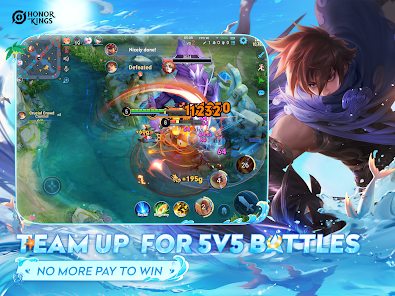
GameInfoX
What Makes Honor of Kings So Popular? 🎯
In a world where there are all sorts of mobile games, there are several great and not-so-great reasons why Honor of Kings is exceptional. The developer's dedication to creating a rich and immersive experience is one of the key factors: The developer's dedication to creating a rich and immersive experience is one of the key factors: - Balanced Gameplay: Thanks to the rather high frequency of updates, cheating, and other unfair methods are ruled out. That’s why in the league players do not buy more advantages and different boosts but rely on skill and strategy. - Constant Updates: The developers of Honor of Kings release many updates on new content, the balance of cards, and special events to attract players. Make sure you get informed about the new updates and news for a better and more advanced knowledge base. - Hero Diversity: There are over 100 heroes to pick which means that players can always try out a new strategy all the time. It is also noteworthy that the variety of heroes is very big and beautiful whether you play a mage, a tank, or a marksman. To know what heroes are currently strong in the Honor of Kings Tier List you have to read the following post. - Esports and Competitive Scene: It has competitive esports activity that comprises popular competitions that are participated by some of the best talents. While it is possible to play the game for fun, some players strive to be at a professional level and the game caters to them.
Developer Insights: Crafting a Mobile MOBA Masterpiece 🛠️
That which sets a Timi Studio as a developer is that they successfully port an entire genre from the PC platform while maintaining the same level of interest on the mobile platform. User interface game controls, and optimization of the game to be played in low-end gadgets make the game to be enjoyed by everyone. Some key development innovations include: Some key development innovations include: - Mobile Optimization: Creating a mobile version of MOBA without lavish elements of the PC games but without making it less interesting and involved. - Localized Servers: The following are the goals that a successful online gaming platform should have; Hosting regional servers to enhance gameplay and company for players from around the world. - AI Integration: Managing to regain control of disconnected players for a short interval of time to maintain the flow of the game.
Honor of Kings Game Codes: Unlock Exclusive Rewards! 🎁
If you are in search of ways on how you can enhance your gameplay then this article is especially meant for you. Developers provide special Honor of Kings game codes from time to time meaning you have a chance of getting skins, heroes, and other items for free. The Honor of Kings game codes and alerts will help you get the new free items!
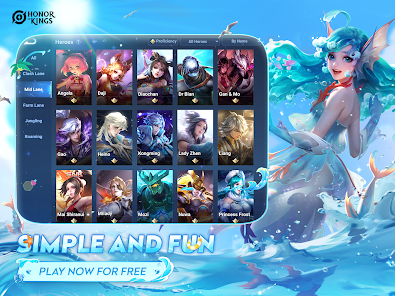
GameInfoX
The Future of Honor of Kings 🌟
The developer of Honor of Kings isn’t showing a sign of slowing down soon. Through continuous new creations, new characters, and global development strategies, Timi Studio has been determined to open up a new chapter of the mobile game market. The game has been expanding its reach in the Western markets and therefore the popularity is undeniably global with the upcoming international tournaments alongside collaboration, Honor of Kings has every reason to look forward to a sunny tomorrow. It won’t harm to check the Honor of Kings' latest update and news to be on the lookout for new features and announcements that come out.
Frequently Asked Questions About Honor of Kings and Its Developer 🙋♀️
Q.1 Who developed the Honor of Kings? A1: Honor of Kings, is developed by Tencent’s Timi Studio which is considered among the top mobile game developing studios worldwide. Q2: With what frequency does the game get updated? A2: There are updates frequently from the developers such as new heroes, balance changes, and new seasonal events. For the latest update about the global smoking population, refer to the latest news. Q3: How can I get the Honor of Kings game codes? A3: It is usual to provide game codes for participants of certain events or while conducting some promotion. It is also advisable to keep on visiting the game codes tab for the most recent out there. Q4: What are the unique approaches in Timi Studio as a developer? A4: Mobile games Timi Studio stresses developing extremely fun games with the use of modern technology, beautiful controls, and active listening to the customers. Q5: Which city does Timi Studio firm call home? A5: The Timi Studio is international and has branches such as the Singapore branch that facilitate operation in other countries.
Conclusion: The Visionary Minds Behind Honor of Kings 🎮
This is not the case with Honor of Kings On the downside we have an addictive game that is dominating the mobile gaming market. Timi Studio has always maintained the quality of content they produce focusing on innovation but also on the players’ opinions which led them to develop one of the most engaging mobile games. Their attention to constant updates and the rich selection of heroes, along with a global esports brother, proves that Honor of Kings’ future is safe. Wait for more information from the developers do not let yourself stay up-to-date with the Latest News And Updates of Honor and do not fail to discover more on game codes to enhance your gameplay! Total Words: 950 Read the full article
0 notes
Text
The Future of Hybrid mobile App Development: 5 Frameworks to Watch
There are various types of mobile apps such as Native, Hybrid, Web, and Progressive Web Apps. Out of all, having a hybrid mobile app has the most benefits since it has characteristics of both Native and Hybrid apps. Hybrid app frameworks are the ones that make it possible to create the most versatile and most advanced app types and in this blog, we will discuss the top 6 hybrid app development framework and their benefits and if you become convinced of the benefits of hybrid apps, we suggest you to hire dedicated hybrid mobile app developers to develop a best hybrid mobile app for your business.

Top 5 Frameworks to Watch while Developing a Hybrid App
1. React Native
React Native is one of the most popular and effective frameworks for hybrid apps. It was developed by Facebook in 2015. React Native is written in JavaScript, Java, C++, Objective-C, and Python and is used by both iOS 9+ and Android 4.1+. The popular apps using React Native apps are Uber Eats and Skype.
There are various advantages offered by React Native such as features like live and hot reloading, intuitive modular architecture, 90% of the code can be reused across iOS and Android, and a Quick installation process, among others.
2. Flutter
Flutter is the only mobile SDK that provides reactive styles without any Javascript bridge. It was released in 2017 and developed by Google. It uses Dart language and is used by both iOS 9+ and Android 4.4+. The popular apps using Flutter are Hamilton and Alibaba.
Flutter offers benefits like fast code writing, a faster testing process due to a single codebase, and rich widgets that can be customized, interactive, and easily adaptable by different screens. Get help from hybrid app development services to get a hybrid app using the Flutter framework.
3. Ionic
Ionic has a powerful front-end Software Development Kit (SDK) that helps you enhance the functionality of an app. It helps in integrating an app with any Javascript framework such as Vue, React, and Angular. It was released by Drifty in 2013 and is written in JavaScript. It is backed by iOS 8+ and Android 4.1+ and apps such as Sanvello and JustWatch are using it.
The benefits of Ionic are it enables code once and runs it everywhere, enables integration with high-end plug-ins, is easy to adopt due to a low learning curve, and is easy and convenient to test.
4. Xamarin
Xamarin is one of the best apps used for cross-platform apps for iOS, Android, and Windows Phone in C# with Visual Studio. Xamarin uses the .NET platform and helps in continuous developer support, wide learning opportunities, and full technical backing by Microsoft. It was released in 2011 by Microsoft and written in C# language. Both iOS 9+ and Android 4.4+ support it and platforms such as Alaska Airlines, and Outback Steakhouse.
The benefits of Xamarin are it can share up to 90% of its codebase across major platforms, is easy to update, test, and maintain, and provides testing tools. You can get help from developers for hybrid mobile applications to incorporate Xamarin for mobile app development.
5. NativeScript
NativeScript helps in developing apps for mobile using JavaScript or TypeScript. This framework gives the experience of native user experience to each mobile OS platform. It was released in 2014 and was developed by Progress Software (formerly Telerik). It has been written in JavaScript, and TypeScript and backed by platforms such as iOS 9+, and Android 4.2+. Popular apps such as Daily Nanny, and Regelneef, among others.
The benefits offered by NativeScript are developer-friendly CLI (Command Line Interface), direct access to all iOS and Android APIs, use of XML-Esque-based markup language, and easy and quick app debugging.
Stay Updated in the World of Technology Using Hybrid App Development Framework!
Using the discussed hybrid app development framework can help your business grow rapidly. Having a hybrid app increases your reach and makes it convenient for your target audience to use and interact with your business. We suggest you consult with hybrid app development services to understand which framework is most suitable for your business and get a perfectly developed hybrid app for your business!
#hire dedicated hybrid mobile app developers#hybrid app development services#developers for hybrid mobile applications
0 notes
Text
Unlock the Power of React Native: A Complete Guide to App Development Success
Introduction to React Native
React Native is a revolutionary framework that allows developers to create mobile applications using JavaScript and React. Since its inception by Facebook in 2015, React Native has transformed the landscape of mobile app development by enabling cross-platform compatibility without sacrificing performance or user experience. This comprehensive guide will delve into the myriad benefits of React Native, its core features, and best practices to ensure your app development project is a resounding success.
Why Choose React Native for App Development?
Cross-Platform Development
One of the most compelling reasons to choose React Native is its ability to build applications for both iOS and Android from a single codebase. This reduces development time and costs significantly, allowing for a more streamlined and efficient workflow.
High Performance
React Native leverages native components to ensure high performance. Unlike hybrid frameworks that rely on WebView, React Native’s architecture bridges the gap between JavaScript and native code, resulting in smoother animations and faster load times.
Rich Ecosystem and Community Support
The extensive ecosystem of libraries and tools available for React Native accelerates development and problem-solving. Moreover, the active and vibrant community provides ample resources, tutorials, and forums for support.
Key Features of React Native
Hot Reloading
Hot Reloading is a feature that significantly enhances developer productivity. It allows developers to see changes in real time without rebuilding the entire application. This leads to quicker iterations and more efficient debugging.
Modular Architecture
React Native's modular architecture enables different developers to work on separate modules, enhancing collaboration and project manageability. This modularity also makes it easier to maintain and upgrade the application.
Live and Hot Reloading
React Native supports live and hot reloading, allowing developers to inject new versions of files while an app is running. This feature is particularly useful for tweaking the UI and fixing bugs on the fly, ensuring a seamless development process.
Getting Started with React Native
Setting Up the Development Environment
Before starting with React Native, you need to set up your development environment. Here are the essential tools and steps:
Node.js and npm: Ensure you have Node.js installed. npm (Node Package Manager) is included with Node.js and is necessary for managing packages.
React Native CLI: Install the React Native CLI using npm.
java
Copy code
npm install -g react-native-cli
Android Studio/Xcode: Depending on your target platform, install Android Studio for Android development or Xcode for iOS development.
Integrated Development Environment (IDE): While you can use any code editor, Visual Studio Code is highly recommended due to its robust support for JavaScript and React Native.
Creating Your First React Native Project
Once your environment is set up, create a new React Native project by running:
csharp
Copy code
react-native init MyNewProject
This command sets up a new project directory with all the necessary files and dependencies.
Running the Application
Navigate to your project directory and start the application:
arduino
Copy code
cd MyNewProject
react-native run-android
or
arduino
Copy code
react-native run-ios
This will launch your application on an emulator or physical device connected to your development machine.
Best Practices for React Native Development
Code Organization
Maintaining a well-structured codebase is crucial for scalability and maintenance. Follow these practices:
Component-based architecture: Break down your UI into reusable components.
Folder structure: Organize your files logically, separating concerns like components, screens, services, and utilities.
State Management
Managing state effectively is vital for building dynamic applications. While React Native comes with built-in state management, libraries like Redux or MobX can be used for more complex state management needs.
Performance Optimization
Ensure your app runs smoothly by adhering to performance best practices:
Avoid unnecessary renders: Use PureComponent and shouldComponentUpdate to prevent unnecessary renders.
Optimize images: Use appropriate image sizes and formats, and consider using tools like FastImage for better performance.
Reduce memory usage: Profile and monitor memory usage, and avoid memory leaks by cleaning up resources appropriately.
Testing Your React Native Application
Unit Testing
Unit tests verify that individual components of your application work as expected. Libraries like Jest and Enzyme are popular choices for unit testing React Native applications.
Integration Testing
Integration tests ensure that different parts of your application work together. Detox is a powerful library for end-to-end testing, offering robust features for testing user interactions.
Continuous Integration (CI)
Implementing CI tools like CircleCI or Travis CI helps automate the testing process, ensuring your codebase remains stable and functional as new changes are introduced.
Deploying Your React Native App
Building for Production
Prepare your application for production by optimizing performance and ensuring stability:
Code minification and obfuscation: Use tools like ProGuard for Android and built-in Xcode options for iOS to minify and obfuscate code.
Enable production mode: Ensure you build your app in production mode to take advantage of optimizations.
arduino
Copy code
react-native run-android --variant=release
react-native run-ios --configuration Release
App Store Submission
Follow these steps to submit your application to app stores:
Android: Generate a signed APK and upload it to the Google Play Console.
iOS: Archive your project in Xcode and submit it through the Apple Developer Console.
Conclusion
React Native is a powerful and versatile framework that bridges the gap between web and mobile app development, providing a robust solution for building high-quality, cross-platform mobile applications. By following best practices, leveraging its rich ecosystem, and staying up-to-date with the latest advancements, you can unlock the full potential of React Native and achieve app development success.
0 notes